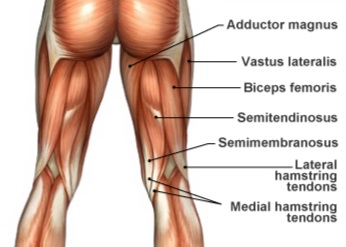2 Halfs of a Hamstring
I had a new marketing pitch from a company that wanted me to promote their new workout program, and after looking through it briefly I decided it wouldn’t be worth my time and effort to give much airtime to it. For one, they had a day devoted entirely to hamstring training, as a fat loss program. Two, it looked pretty much identical to a program I saw in Flex magazine way back in 1997, but it didn’t have the seated hamstring or lying hamstring curl machines thrown in there.
Essentially, it was 9 variations on deadlifts.
By itself, this isn’t a bad thing, because deadlifts rock. Using them as the only method for training your hamstrings is like saying the only way to use a staircase is to go up. Sure, you COULD use other means to get back downstairs, but seriously, the stairs are as effective at going down as they are for going up. The only pass is a firehalls pole to get to the trucks faster, or possibly a slide.

The 2 main functions of the hamstring are to extend the hip, but also to flex the knee. There’s some element of involvement with adduction and rotation of the hip as well, but those are more tertiary functions, so let’s focus on the 2 big rocks.
The hamstring group is actually 3 individual muscles, the semimembranosus and semitendinosus on the inner half of the leg and the biceps femoris on the outer half of the leg. They all originate on the ischial tuberosity of the hip (sit bones in your butt) and attach to the tibia and fibula, respectively. In an open chain movement, they have the ability to contribute to controlled rotation of the tibia against the femur, and in a closed chain setting they can contribute to extending the knee during the concentric phase of a squat.

Because of all these different functions, a training program that wants to develop the muscle should use a bunch of different modalities and movements, not simply just deadlifts. Will you get some development with only deadlifts? Absolutely, but it won’t prepare you for getting stronger in a knee flexed position when you need it.
Because of this, I wanted to outline a bunch of movements you could use to train the hamstrings in both a hip dominant and knee dominant method so you can get the best use of the muscle, and use the stairs to go up and down, so to speak.
Hip Dominant
A big key with all of these movements is to ensure you’re bending from the hip and not from the spine. Make sure you are bracing the abs so there’s no secondary spinal motion occurring that you may not want or need, and go deep into the stretch on those creamy hamstrings.
If you only did these during your workouts, it would be a solid workout, and walking would be entirely optional the following day. That being said, let’s add in some knee dominant hamstring movements to round out the workouts.
Knee Dominant
*warning: these suck
Technically involves both a hip extension and knee flexion movement.
Give some or all of these a shot. If you do them all, be warned that much like the Grinches heart, your hammies may grow three sizes that day.
2 Responses to 2 Halfs of a Hamstring